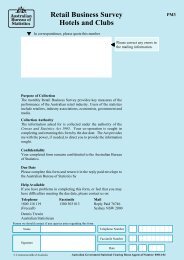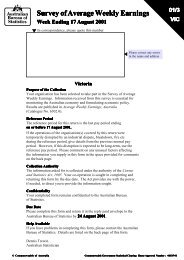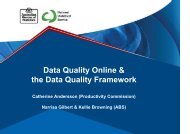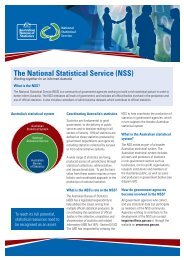SAE Manual Sections 1 to 4_1 (May 06).pdf - National Statistical ...
SAE Manual Sections 1 to 4_1 (May 06).pdf - National Statistical ...
SAE Manual Sections 1 to 4_1 (May 06).pdf - National Statistical ...
You also want an ePaper? Increase the reach of your titles
YUMPU automatically turns print PDFs into web optimized ePapers that Google loves.
A Guide <strong>to</strong> Small Area Estimation - Version 1.1 05/05/20<strong>06</strong><br />
estimates of disability, we used auxiliary variables such as age, sex, income and<br />
household structure, found on the SDAC survey file <strong>to</strong> fit the model and then used the<br />
corresponding variables on the population census file <strong>to</strong> make the small area<br />
predictions.<br />
When considering potential sources of auxiliary data it is highly advisable <strong>to</strong> cast a wide<br />
net and assess the value of data that may not on first reflection appear highly relevant.<br />
For example, in the context of disability data, an economic variable in addition <strong>to</strong> health<br />
related variable may have good predictive power. Some caution however needs <strong>to</strong> be<br />
exercised as it is possible that the correlation between the target and some of the more<br />
tenuous auxiliary variables is more due <strong>to</strong> coincidence than <strong>to</strong> an intrinsic real world<br />
relationship between the two. Such auxiliary variables are referred <strong>to</strong> as spurious<br />
auxiliary variables.<br />
Demographic information is a particular form of auxiliary information, relating <strong>to</strong><br />
population attributes such as age and sex. Many social variables will have some<br />
relationship <strong>to</strong> such demographic data thereby necessitating its use. However there is<br />
another reason for using demographic information and that is where the population size<br />
or demographic composition of small areas varies considerably. In Australia, with its<br />
extreme variation in population densities, this is a very common issue.<br />
Cross-sectional relationships<br />
Cross-sectional correlations are intrinsic relationships between units (observed at the<br />
same time point) with similar characteristics, even if they are not in the same small area.<br />
For example, units with the same age, sex and occupational characteristics may have<br />
similar health outcomes regardless of whether they live in Sydney or Melbourne. Small<br />
area methods borrow strength cross-sectionally by pooling sample data across a broader<br />
area (thus obtaining more statistical reliability) and then adjusting each small area<br />
estimate according <strong>to</strong> it's age-sex-occupation profile. In practice, borrowing strength<br />
cross-sectionally may be restricted <strong>to</strong> a predefined broader region if it is believed that<br />
cross-sectional relationships are likely <strong>to</strong> be different between regions. For example<br />
exposure <strong>to</strong> air pollutants is likely <strong>to</strong> be similar for Sydney and Melbourne but different<br />
<strong>to</strong> that of other cities. Hence Sydney and Melbourne may be combined in<strong>to</strong> a broader<br />
region within which cross-sectional relationships can be drawn upon.<br />
Time Series Relationships<br />
Borrowing strength across time enables the practitioner <strong>to</strong> effectively pool sample data<br />
across time. The sample in each small area may be very sparse at a given time point,<br />
however if a sufficiently long time series exists and au<strong>to</strong>-correlations across time are<br />
reasonably strong, data from a number of time points can be pooled <strong>to</strong>gether giving a<br />
larger effective sample size <strong>to</strong> utilize in each small area. Time series au<strong>to</strong>-correlations are<br />
utilised <strong>to</strong> adjust for the degree of similarity or dissimilarity between units observed at<br />
specified time periods apart. This approach also has the benefit of reducing the impact<br />
of an observed value that is discordant with its neighbouring values in time. Borrowing<br />
strength across time adds a considerable degree of complexity <strong>to</strong> small area estimation<br />
and should only be contemplated where statistical expertise is available.<br />
Australian Bureau of Statistics 17








